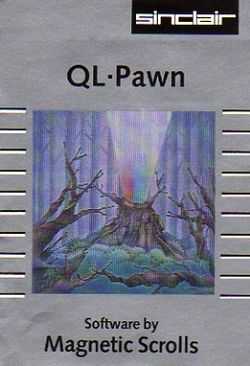The Pawn
| The Pawn | |
|---|---|
 Cover art | |
| Developer(s) | Magnetic Scrolls |
| Publisher(s) | Rainbird Software |
| Designer(s) | Rob Steggles |
| Platform(s) | Amiga, Amstrad CPC, Amstrad PCW, Apple II, Acorn Archimedes, Atari ST, Atari 8-bit, Commodore 64, MS-DOS, Apple Macintosh, Sinclair QL, Sinclair Spectrum.[1] |
| Release date(s) | 1985 |
| Genre(s) | Interactive fiction |
| Mode(s) | Single-player |
| Distribution | Floppy disk, cassette, microdrive |
The Pawn is an interactive fiction game by Magnetic Scrolls which was first published by Rainbird in 1985. It is remembered for its excellent graphics (on some versions) and the opening music available in some game versions. Also the game itself - story and parser - got mostly positive reviews. The story takes place in the fairy land of Kerovnia, from which the player must escape.
The game was written in 68000 assembler, later versions were implemented using a cut-down 68000 virtual machine even on lesser machines like the z80 based Sinclair Spectrum.
Amiga version's title music
The Commodore Amiga version is notable for using digitized instrument samples in its title music. When the game was released, the Amiga was the only home computer which had hardware support for digitized samples. However, there was probably no other Amiga game released in 1986 that utilized the capabilities of Amiga's Paula sound chip like The Pawn did. This means that The Pawn was a pioneer release in the field of digitized computer game music. The peaceful title music was composed by John Molloy and it features guitar and flute sounds among others.
Reception
Compute! described The Pawn as "parod[ying] the entire genre of interactive fiction, showing us that much of it—even the serious stuff—has its shortcomings", giving as example a character campaigning to eliminate mazes in text adventures. It stated that some of the Atari ST version's graphics were "superb" but wished that the pictures contributed to solving the game instead of being optional. The magazine concluded that "Firebird has given us a good adventure, one that bodes well for the company and for all of us adventurers".[2] Computer Gaming World stated that The Pawn "shows how well something can be done for the Amiga when one KNOWS the machine".[3] In Dragon #114's "The Role of Computers" column, reviewers Hartley and Pattie Lesser stated that the game's "“painted” scenes will leave you in awe".[4] The game was reviewed in 1988 in Dragon #134 by Hartley, Patricia, and Kirk Lesser in "The Role of Computers" column. The reviewers gave the game 4 out of 5 stars for IBM micros and compatibles version with an EGA board, but only 21⁄2 stars for systems without an EGA board.[5]
The game won the award for best adventure game of the year in Crash magazine.[6] It was also voted Best Adventure Game of the Year at the Golden Joystick Awards.[7]
References
- ↑ Stefan Meier, "Magnetic Scrolls Fact Sheet", 2009
- ↑ Randall, Neil (October 1986). "The Pawn For Atari ST". Compute!. p. 60. Retrieved 9 November 2013.
- ↑ Wagner, Roy (December 1986). "Amiga Preferences". Computer Gaming World. p. 44.
- ↑ Lesser, Hartley and Pattie (October 1986). "The Role of Computers". Dragon (114): 72–76.
- ↑ Lesser, Hartley, Patricia, and Kirk (June 1988). "The Role of Computers". Dragon (134): 80–86.
- ↑ http://www.crashonline.org.uk/51/awards.htm
- ↑ http://www.worldofspectrum.org/showmag.cgi?mag=C+VG/Issue066/Pages/CVG06600101.jpg
External links
- The Pawn at MobyGames
- Link at If-Legends.org
- Download The Pawn here
- The Pawn at Lemon 64
- Amiga version title music for The Pawn in original format (The LHA-compressed Module file can be listened to with the freely-distributed DeliPlayer program, with the Oldsk00l plugin for Winamp, or UADE)
- The Pawn at World of Spectrum; includes cassette inlay and links to original reviews
- The Pawn at the Magnetic Scrolls Chronicles
- Images of The Pawn package, manual and screen shots
| |||||